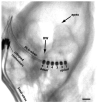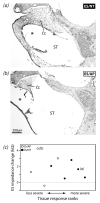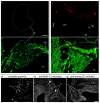Spiral ganglion neuron survival and function in the deafened cochlea following chronic neurotrophic treatment
- PMID: 21762764
- PMCID: PMC3205216
- DOI: 10.1016/j.heares.2011.06.007
Spiral ganglion neuron survival and function in the deafened cochlea following chronic neurotrophic treatment
Abstract
Cochlear implants electrically stimulate residual spiral ganglion neurons (SGNs) to provide auditory cues for the severe-profoundly deaf. However, SGNs gradually degenerate following cochlear hair cell loss, leaving fewer neurons available for stimulation. Providing an exogenous supply of neurotrophins (NTs) has been shown to prevent SGN degeneration, and when combined with chronic intracochlear electrical stimulation (ES) following a short period of deafness (5 days), may also promote the formation of new neurons. The present study assessed the histopathological response of guinea pig cochleae treated with NTs (brain-derived neurotrophic factor and neurotrophin-3) with and without ES over a four week period, initiated two weeks after deafening. Results were compared to both NT alone and artificial perilymph (AP) treated animals. AP/ES treated animals exhibited no evidence of SGN rescue compared with untreated deafened controls. In contrast, NT administration showed a significant SGN rescue effect in the lower and middle cochlear turns (two-way ANOVA, p < 0.05) compared with AP-treated control animals. ES in combination with NT did not enhance SGN survival compared with NT alone. SGN function was assessed by measuring electrically-evoked auditory brainstem response (EABR) thresholds. EABR thresholds following NT treatment were significantly lower than animals treated with AP (two-way ANOVA, p = 0.033). Finally, the potential for induced neurogenesis following the combined treatment was investigated using a marker of DNA synthesis. However, no evidence of neurogenesis was observed in the SGN population. The results indicate that chronic NT delivery to the cochlea may be beneficial to cochlear implant patients by increasing the number of viable SGNs and decreasing activation thresholds compared to chronic ES alone.
Copyright © 2011 Elsevier B.V. All rights reserved.
Figures








Similar articles
-
Delayed electrical stimulation and BDNF application following induced deafness in rats.Acta Otolaryngol. 2009 Feb;129(2):142-54. doi: 10.1080/00016480802043949. Acta Otolaryngol. 2009. PMID: 18607918
-
Chronic neurotrophin delivery promotes ectopic neurite growth from the spiral ganglion of deafened cochleae without compromising the spatial selectivity of cochlear implants.J Comp Neurol. 2013 Aug 15;521(12):2818-32. doi: 10.1002/cne.23318. J Comp Neurol. 2013. PMID: 23436344 Free PMC article.
-
The effect of deafness duration on neurotrophin gene therapy for spiral ganglion neuron protection.Hear Res. 2011 Aug;278(1-2):69-76. doi: 10.1016/j.heares.2011.04.010. Epub 2011 May 1. Hear Res. 2011. PMID: 21557994 Free PMC article.
-
Neurotrophin gene therapy to promote survival of spiral ganglion neurons after deafness.Hear Res. 2020 Sep 1;394:107955. doi: 10.1016/j.heares.2020.107955. Epub 2020 Apr 5. Hear Res. 2020. PMID: 32331858 Free PMC article. Review.
-
Neurotrophic factors and neural prostheses: potential clinical applications based upon findings in the auditory system.IEEE Trans Biomed Eng. 2007 Jun;54(6 Pt 1):1138-48. doi: 10.1109/TBME.2007.895375. IEEE Trans Biomed Eng. 2007. PMID: 17551571 Free PMC article. Review.
Cited by
-
SCN11A gene deletion causes sensorineural hearing loss by impairing the ribbon synapses and auditory nerves.BMC Neurosci. 2021 Mar 22;22(1):18. doi: 10.1186/s12868-021-00613-8. BMC Neurosci. 2021. PMID: 33752606 Free PMC article.
-
Delayed loss of hearing after hearing preservation cochlear implantation: Human temporal bone pathology and implications for etiology.Hear Res. 2016 Mar;333:225-234. doi: 10.1016/j.heares.2015.08.018. Epub 2015 Sep 1. Hear Res. 2016. PMID: 26341474 Free PMC article.
-
Combined brain-derived neurotrophic factor and neurotrophin-3 treatment is preferred over either one separately in the preservation of the auditory nerve in deafened guinea pigs.Front Mol Neurosci. 2022 Sep 26;15:935111. doi: 10.3389/fnmol.2022.935111. eCollection 2022. Front Mol Neurosci. 2022. PMID: 36226314 Free PMC article.
-
Round-window delivery of neurotrophin 3 regenerates cochlear synapses after acoustic overexposure.Sci Rep. 2016 Apr 25;6:24907. doi: 10.1038/srep24907. Sci Rep. 2016. PMID: 27108594 Free PMC article.
-
Chronic intracochlear electrical stimulation at high charge densities results in platinum dissolution but not neural loss or functional changes in vivo.J Neural Eng. 2019 Apr;16(2):026009. doi: 10.1088/1741-2552/aaf66b. Epub 2018 Dec 5. J Neural Eng. 2019. PMID: 30523828 Free PMC article.
References
-
- Abrous DN, Koehl M, Le Moal M. Adult neurogenesis: from precursors to network and physiology. Physiol Rev. 2005;85:523–569. - PubMed
-
- Agterberg MJ, Versnel H, de Groot JC, Smoorenburg GF, Albers FW, Klis SF. Morphological changes in spiral ganglion cells after intracochlear application of brain-derived neurotrophic factor in deafened guinea pigs. Hear Res. 2008;244:25–34. - PubMed
-
- Agterberg MJ, Versnel H, de Groot JC, van den Broek M, Klis SF. Chronic electrical stimulation does not prevent spiral ganglion cell degeneration in deafened guinea pigs. Hear Res. 2010;269:169–179. - PubMed
Publication types
MeSH terms
Substances
Grants and funding
LinkOut - more resources
Full Text Sources
Other Literature Sources
Medical
Research Materials

